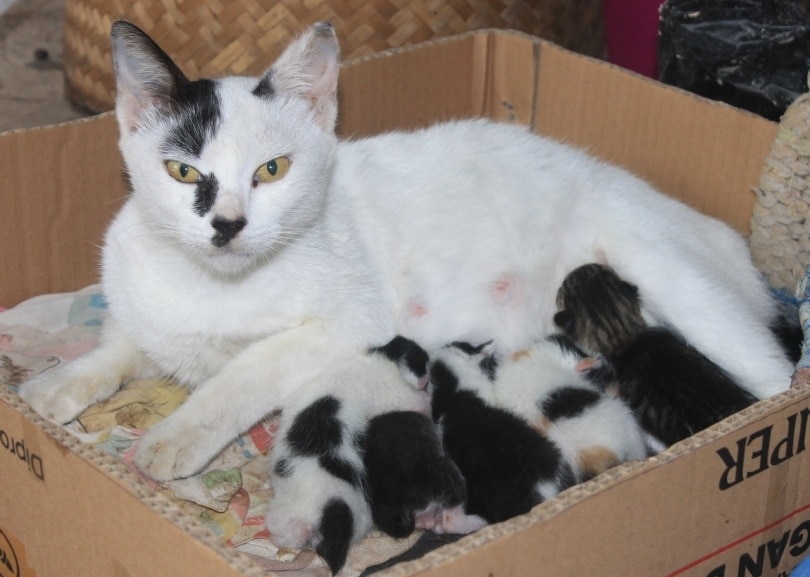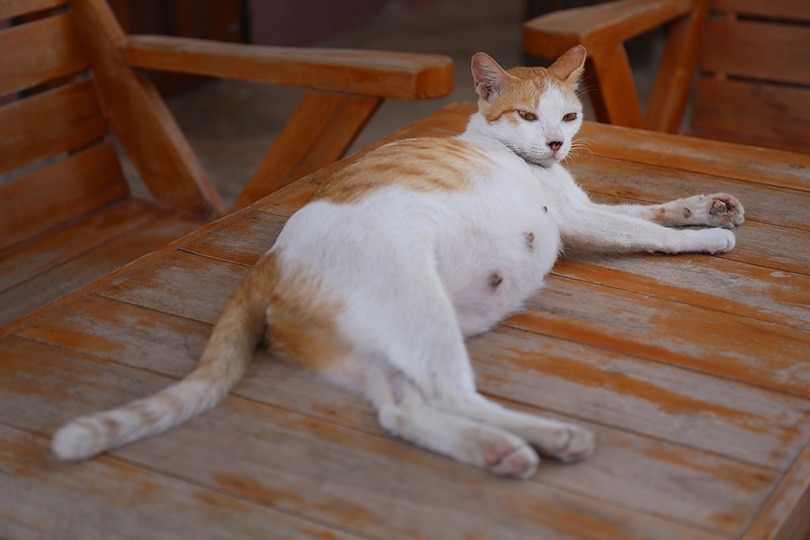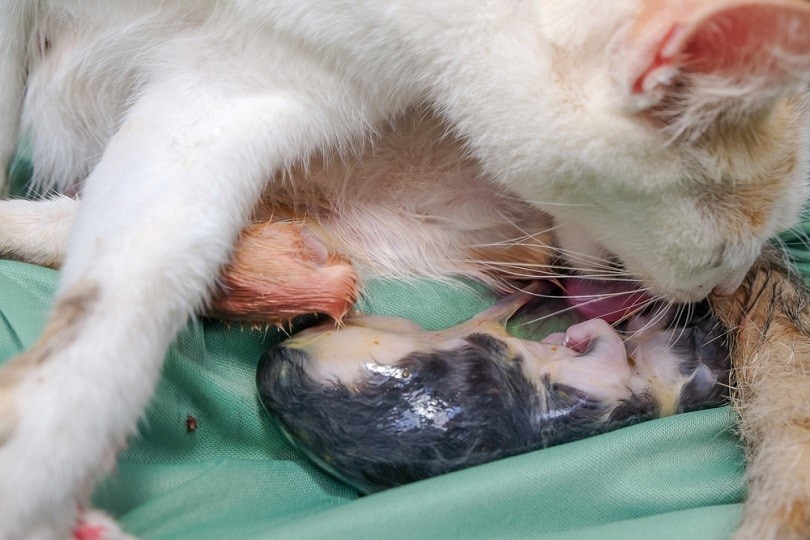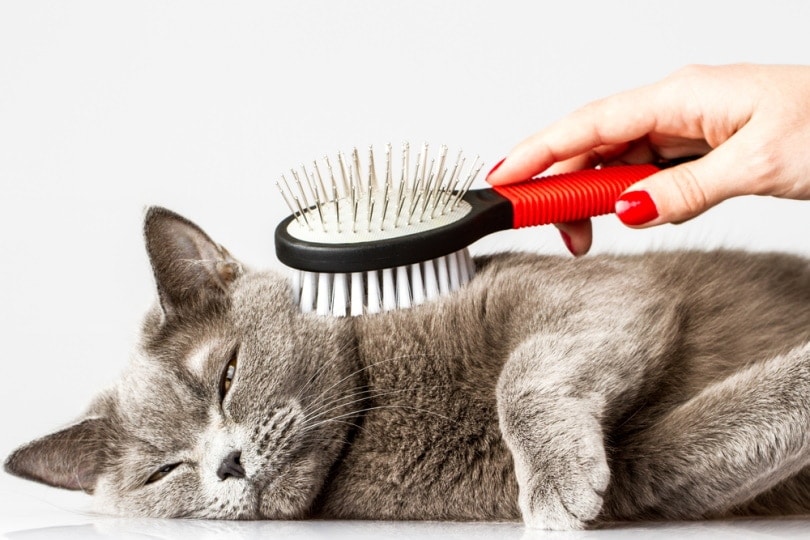How Do Cats Give Birth? Vet Approved Explanation
By Jordyn Alger
Updated on

Is your kitty expecting? As exciting as it can be to welcome new kittens into the world, the process can also be stressful. Giving birth isn’t easy, after all, and so it is vital that you provide the best care possible for your cat while she is in labor.
To prepare for the birth of kittens, you will need to make proper arrangements, know the signs of impending labor, and understand the stages of cat birth. In this article, we’ll discuss the birthing process and how you can make your feline as comfortable as possible.
Preparing for Your Cat’s Labor
Before your cat goes into labor, there are arrangements that you must make. To be fully prepared and minimize the chances of unpleasant surprises, you must estimate your cat’s due date. Typically, this is 63–68 days after mating.
Another way to be prepared is to have your veterinarian’s number on hand. If you need advice or if something goes wrong, you don’t want to have to search for your veterinarian’s contact information frantically.
Perhaps most importantly, you must set up a kittening box before your cat’s labor. This is the box that your cat will give birth in. You can purchase a container made specifically for this purpose or use an ordinary cardboard box if it has enough room.
The box should be kept in a quiet, safe area of the house where the temperature is around 71°F. It should have an open top and be big enough for your cat to stand, stretch, and turn around. The box should also be lined with towels and other absorbent bedding material, and it must be large enough to fit all of this and offer your cat a free range of motion.
The walls of the box should be high enough to prevent newborn kittens from crawling too far away and getting into trouble. Before your cat’s labor, calling your vet and reviewing the process with them is a good idea. Although this article will cover the general process, your vet can tell you any specific information that may be important for your cat.
Recognize the Signs that Labor Will Begin Soon

Once you are fully prepared, you need to watch for signs that labor may begin soon. There is a stage just before birth that lasts around 6–12 hours. Your cat’s behavior will likely change, so pay attention to the following signs:
- Restlessness
- Vocalness
- Hiding
- Excessive grooming, especially around the genitals
- Panting
- Eating less
- Nesting, which is when your cat scratches or paces around the kittening box
- Discharging a small amount of reddish-brown mucus from the vagina
Before the birthing process begins, your cat will likely settle down in the kittening box. If she settles somewhere else, do not move her. She will be fine as she is.
The 4 Stages of Cat Labor
There are three main stages of cat labor. You should be present while your cat is giving birth to observe her and ensure the process goes smoothly. She may not want you hovering too close, so respect her boundaries so that she feels safe and comfortable.
1. Stage One
During the first stage of labor, your cat’s cervix and vagina will relax while the uterus contracts. Uterine contractions will be periodically interrupted by periods of relaxation. Although your cat will be experiencing uterine contractions, these will not yet be observable to your eye. However, you may feel the kittens inside her abdomen (if your cat allows you to touch her).
Your cat may depend on your presence for comfort and reassurance, or she may need her space. She may scratch around the kittening area and pant and should experience minimal vaginal discharge. This stage may last as long as 36 hours.

2. Stage Two
The second stage of labor will involve stronger uterine contractions. The first kitten will begin moving toward the pelvis, which will expel some fluid from your cat’s vagina. Your cat will push to help the kitten through the birth canal. Around this time, you may notice your cat straining.
After stage two begins, it can take anywhere from 5 minutes to 30 minutes for the first kitten to be born. Once the kitten’s head emerges, it should only take your cat a few more moments of straining to birth the kitten entirely.
3. Stage Three
Stage three will follow stage two immediately. This is when your cat passes the membranes and placenta, called the after-birth.
Each set of membranes usually is passed after the birth of each kitten. Sometimes a few kittens may be born before their placentas are passed. With each kitten that is born, your cat will rip open the membranes and clear the mouth and nose of her kitten, enabling them to breathe. If you can, try and count the placentas that are passed so you can let your vet know if one may be left behind as this can be an infection risk.
With each kitten, stages two and three will be repeated. The time intervals between each birth may vary. It may take as little as 10 minutes for the next kitten to be born or as long as 1 hour. The average number of kittens per litter is four, although the amount can reach as high as 12.
Sometimes, your cat will birth one or two kittens and then seemingly stop, even though other kittens are yet to be born. She will eat, drink, rest, and tend to her kittens. This can be a normal resting stage lasting as long as 36 hours before your cat resumes birthing her kittens.

4. Post-Birth
After giving birth, your cat will be understandably tired. She will need to have access to food and water, and she will need to be in a secure and quiet location. Make sure that her room is warm and that her bedding is dry. If she does not feel comfortable, she may neglect her kittens. As long as your cat is healthy and cares for her kittens, try giving her and the kittens as much space as possible.
Know When to Contact Your Vet
Although uncommon, your cat can experience complications during or after the birthing process. If you notice any of the following signs, contact your vet immediately:
- Excessive bleeding from the vulva
- Green vulval discharge
- Exhaustion from prolonged labor
- Straining without kittens being born within 20-30 minutes
- A kitten stuck in the pelvis
- Failing to remove sacs from kitten’s faces – tear a small hole in the sac and remove it yourself if your cat does not do it herself.
- Failing to remove umbilical cords
- Passing the due date with no signs of labor
- Neglecting her kittens
- Stillborn kittens
- Any signs that you cat is unwell or not herself while in labor or after giving birth
Even if you do not notice these signs, do not hesitate to reach out to your vet whenever you are concerned or feel out of your depth.
Conclusion
Supporting your cat through her labor can be a stressful experience, but it can also be incredibly rewarding. Once the process is complete and the pressure is gone, you will have the wonderful opportunity to marvel at the life you witnessed come into the world. Even after your cat completes the birthing process, observe her to ensure no lingering complications. Reach out to your vet anytime you are worried about your cat’s or kittens’ well-being.
Featured Image Credit: azkia_am, Pixabay













